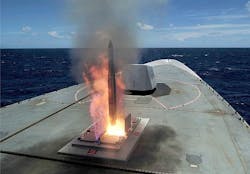Raytheon prepares to build batch of next-generation radar-guided shipboard anti-aircraft missiles
Officials of the U.S. Naval Sea Systems Command in Washington announced a $97.8 million order to the Raytheon Missile Systems segment in Tucson, Ariz., on Monday for RIM-162 Evolved Sea Sparrow Missile (ESSM) Block 2 long-lead items for 2019 low-rate initial production (LRIP). RIM stands for radar intercept missile.
The ESSM Block 2, scheduled for deployment with the Navy and allied navies in 2020, is a ship self-defense missile with a dual-mode X-band radar seeker than can engage enemy planes and missiles at ranges beyond 25 miles.
Long-lead items either are difficult and time-consuming to obtain, and are funded early in the aircraft design process to keep overall production on schedule. Contracts to build the missile will come later.
Low-rate initial production describes a phase of initial small-quantity production that enables the Navy, Raytheon, and Raytheon's suppliers to perform final testing, and tool-up for mass production.
Compared with its ESSM Block 1 predecessor, the shipboard ESSM Block 2 missile will have increased maneuverability and other enhancements that will enable it to defeat future threats to U.S. and allied navies operating in hostile environments, Raytheon officials say. The ESSM Block 2’s active seeker will support terminal engagement without the launch ship’s target illumination radars.
In addition to the U.S. Navy, the governments of Australia, Belgium, Canada, Denmark, Germany, Greece, The Netherlands, Norway, Portugal, Spain, and Turkey will operate ESSM Block 2.
ESSM is a medium-range, semi-active homing missile that makes flight corrections via radar and midcourse data uplinks. The missile provides reliable ship self-defense capability against agile, high-speed, low-altitude anti-ship cruise missiles, low velocity air threats like helicopters, and high-speed, maneuverable surface threats.
The missile is 12 feet long and has 10-inch-diameter control and rocket motor sections that tapper to an 8-inch-diameter guidance section with a radome-protected antenna for semi-active homing and a warhead. It has a high-thrust, solid-propellant rocket motor and tail control via a thrust vector controller.
The first production ESSM Block 1 was delivered in late 2002 and has been in full operational use in the U.S. since 2004.
On this order Raytheon will do the work in Ontario Canada; Andover, Mass.; Munich, Germany; Edinburgh, Australia; San Jose, and West Village, Calif.; Hengelo, The Netherlands; Madrid, Spain; Nogales, Mexico; Athens, Greece; Aarhus, Denmark; Ankara, Turkey; Cincinnati; Canton, N.Y; Portland, Ore; Marinha Grande, Portugal; and Tampa, Fla., and should be finished by March 2023.
For more information contact Raytheon Missile Systems online at www.raytheon.com, or Naval Sea Systems Command at www.navsea.navy.mil.
Ready to make a purchase? Search the Military & Aerospace Electronics Buyer's Guide for companies, new products, press releases, and videos
